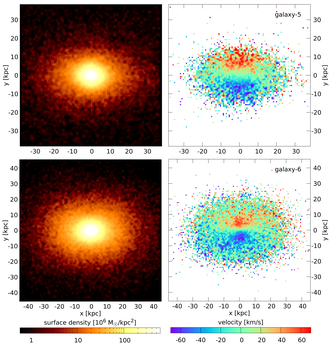
In most galaxies stars rotate around the shortest axis of the galaxy. Recently, galaxies with the rotation around the longest axis, so called “prolate rotation”, were discovered, including two dwarfs in the Local Group. Their number is increasing due to ongoing surveys with spatially resolved spectroscopy. Ivana Ebrová and Ewa Łokas from Copernicus Center studied their origin using the publicly available data from Illustris, a large cosmological simulation that follows the coevolution of visible and dark matter from high redshifts to the present time.
They examined all 7700 galaxies from the last simulation snapshot with mass comparable to the Large Magellanic Cloud or higher and identified 59 convincing examples of galaxies with prolate rotation. The figure shows two examples of such simulated galaxies. The left panels show the surface density of stars, which corresponds to the light distribution in the galaxies. The right panels show maps of the mean line-of-sight velocity of stars: the upper parts of the galaxies are rotating on average towards the observer while the bottom parts are moving away. The rotation is therefore around the long axis of the stellar distribution. The investigation of the properties and history of the simulated galaxies with prolate rotation led to the conclusion that in a vast majority of cases the birth of prolate rotation is related to a significant merger with another galaxy. These mergers were then compared to mergers experienced by similar galaxies in Illustris that do not show prolate rotation. On average, mergers leading to prolate rotation were more recent, the trajectories of the merging galaxies were more radial and the swallowed galaxies were more massive. However, there is no unique recipe for creating a galaxy with prolate rotation. At the beginning of the merger the galaxies can have diverse spatial orientations, velocities and mass ratios. The birth of prolate rotation is determined at the final stages of the merger and depends on details of the merger which are difficult to predict. Contrary to previous suggestions, prolate rotation can result from mergers of galaxies with significant amount of gas. In addition, the galaxies with prolate rotation at the end of the simulation comprise quite a diverse group. The rotation can be provided by stars originating from one or both merger progenitors or it can be even dominated by stars created after the merger. The galaxies with prolate rotation have various masses but they are more often found among very massive galaxies. This trend is also followed by real observed galaxies with prolate rotation. The results were obtained as part of the project "Dynamics and morphology of interacting galaxies" funded by the National Science Centre within the Maestro program. The article Galaxies with prolate rotation in Illustris describing these findings has been accepted for publication in The Astrophysical Journal.






